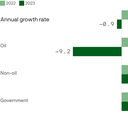Grim Saudi growth underscores oil's importance to the economy.

One look at Saudi Arabia's latest growth figures explains why the Gulf giant has struggled mightily to boost global crude prices.
Driving the news: With oil prices capped despite widespread geopolitical turmoil, Saudi Arabia's growth turned grim in 2023, with gross domestic product tumbling by -0.9 percent, compared with 8.7 percent in 2022.
Why it matters: A core member of OPEC, the kingdom is one of the world's largest producers of crude, which plays a crucial role in its revenue picture. Oil accounts for 40 percent of Saudi's GDP, which saw a steep decline in oil activities.
- Meanwhile, crude has shrugged off conflicts in the Middle East, with markets focused on worries about demand.
Catch-up quick: Rising supply from non-cartel economies — including the U.S. — has steadily chipped away at OPEC's advantage in setting the global energy market agenda and is taking a toll on Saudi Arabia's economy.
- In recent years, the kingdom has taken strides to diversify its economic mix, leaning more on tourism to juice growth.
- Saudi Arabia is also among the top three petroleum producers in the world — the other two being the U.S. and Russia.
By the numbers: The kingdom's oil activities included crude oil, natural gas and refining activities; that segment fell sharply, -9.2% in 2023, compared with a 15.4 percent increase in 2022.
- Overall the economy contracted by 0.9 percent in 2023, from 8.7 percent growth in 2022, according to recent estimates by the General Authority for Statistics.
- The country saw a steep decline in oil activities from 6.1 percent in the fourth quarter of 2022 to -16.4 percent in the same quarter for 2023.
- Real GDP decreased by 3.7% in the fourth quarter of 2023 compared with 5.3 percent growth in 2022, as non-oil activities and government activities grew by 4.3% and 3.1% respectively, on an annual basis.
Zoom out: The International Monetary Fund recently revised its estimates for the Middle East and Central Asia, attributing Saudi Arabia's lower oil production in 2024.
- Saudi Aramco, the national oil company of Saudi Arabia, halted its oil expansion plan to limit maximum capacity at 12 million barrels per day — 1 million below the target announced in 2020.